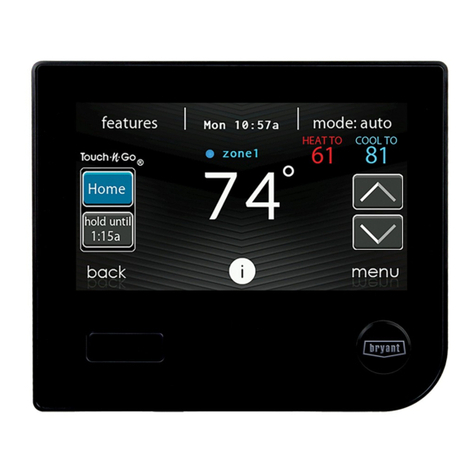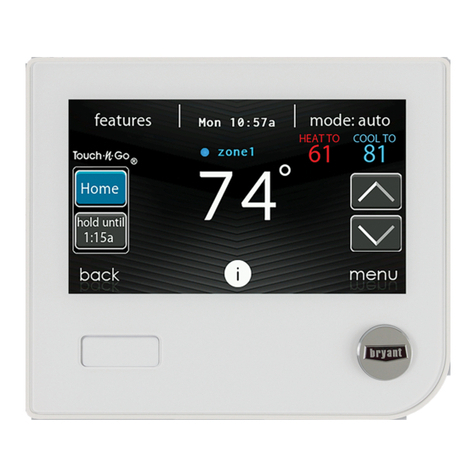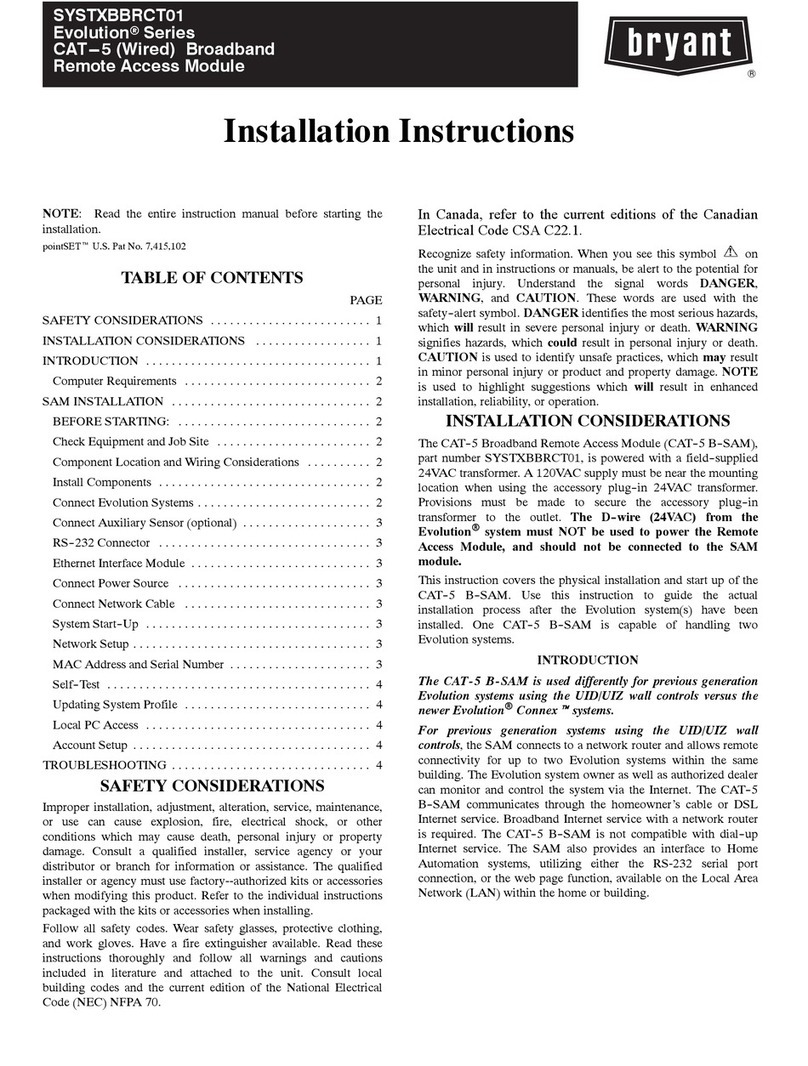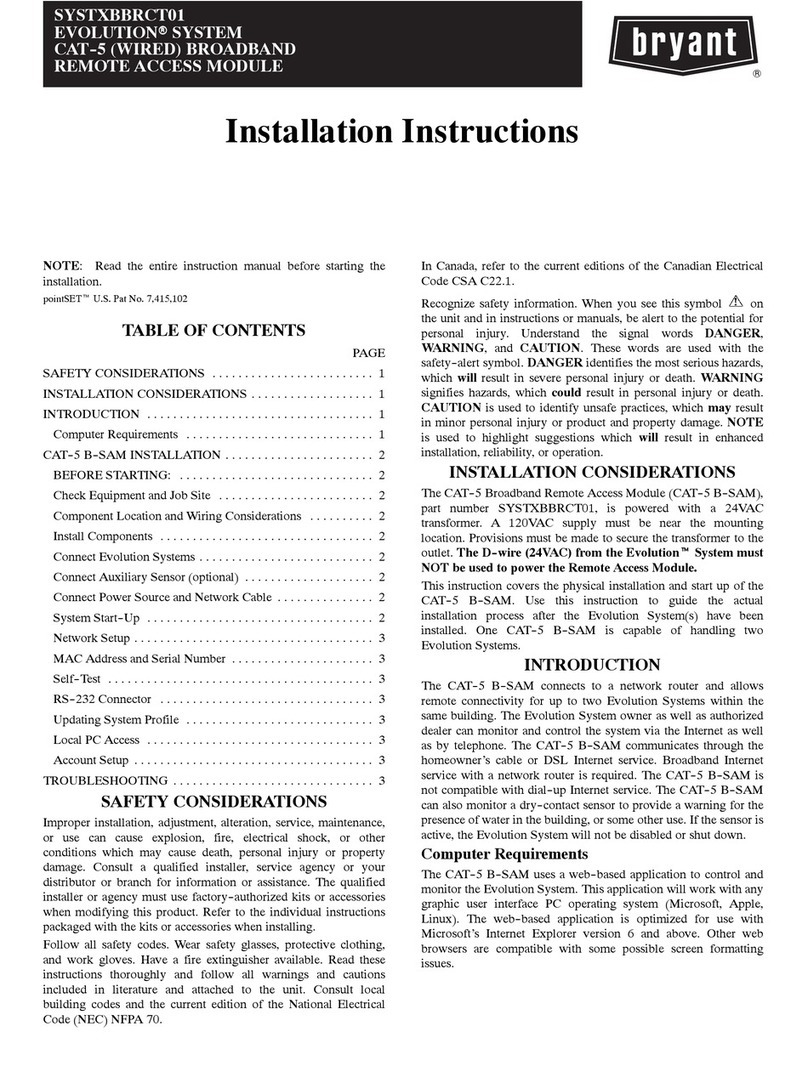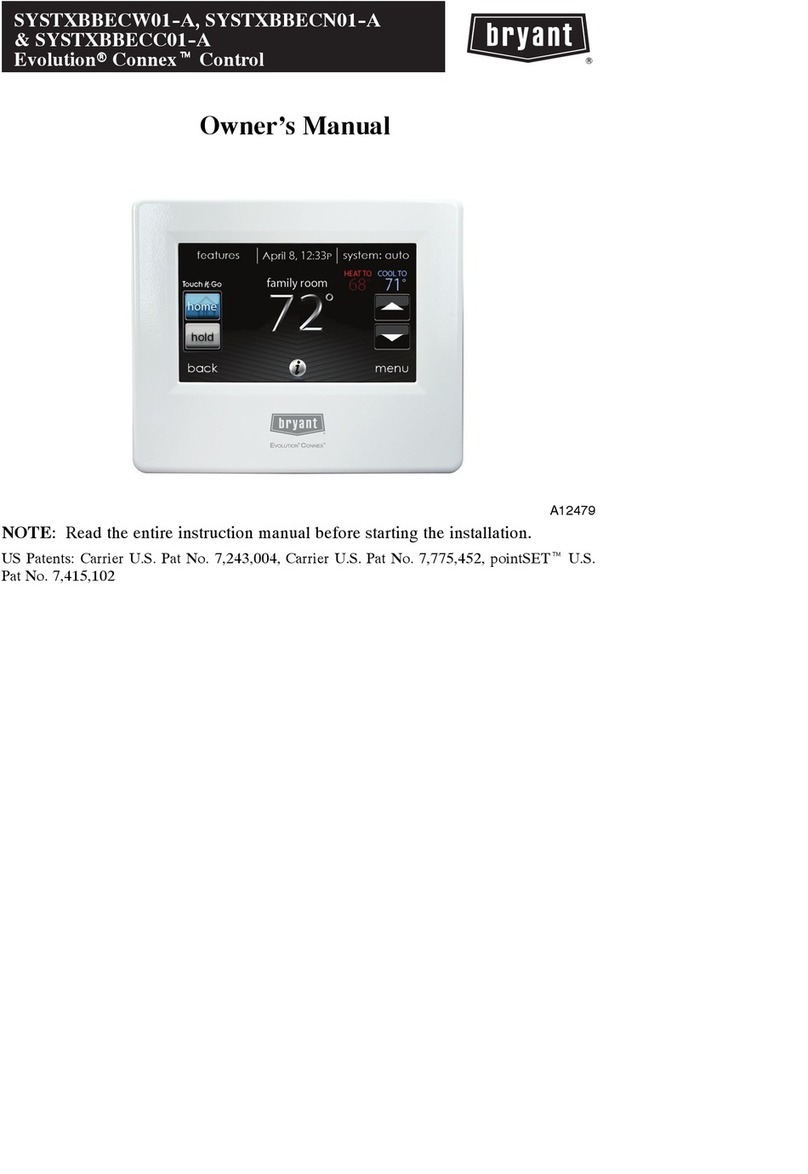
2
SEvolutionrConnextWall Control (p/n SYSTXCBBECC01,
SYSTXBBECW01, or SYSTXBBECN01) — Each installation
has only one Master wall/zoning control. This is the command
center for the entire system. It will typically be located in Zone 1
to sense and control the temperature in this zone. If desired, a
Remote Room Sensor or a Smart Sensor may be used to sense the
Zone 1 temperature. This can give the installer some flexibility in
locating the Master EvolutionrConnextwall control to another
area.
SRemote Room Sensor (p/n SYSTXBBRRS01) — Any zone may
use a Remote Room Sensor (including Zone 1). This is a
temperature sensor only, having no additional user inputs. In
applications where zone temperature averaging may be desired,
this may be done using 4 Remote Room Sensors in a series /
parallel wiring configuration (See Fig. 11 for Remote Room
Sensor Averaging).
SSmart Sensor (p/n SYSTXBBSMS01) — Any zone may use a
Smart Sensor (including Zone 1). It provides a temperature
display and buttons to adjust the desired temperature in that zone
only. It also displays the outdoor temperature and indoor
humidity.
Be sure to select the desired sensor type for each zone. Zone sensors
other than the EvolutionrConnextwall control must be purchased
separately. Installation Instructions for these sensors are included
with them.
INSTALLATION
Step 1 — Check Equipment and Job Site
INSPECT EQUIPMENT—File claim with shipping company,
prior to installation, if shipment is damaged or incomplete.
Step 2 — Component Location and Wiring
Considerations
ELECTRICAL SHOCK HAZARD
Failure to follow this warning could result in personal injury
or death.
Before installing sensor, turn off all power to unit. There may
be more than one power disconnect.
!WARNING
NOTE: All wiring must comply with national, local, and state
codes.
LOCATING EvolutionrDAMPER CONTROL
All system wiring is run back to the EvolutionrDamper Control.
Select a location near the Evolutionrfurnace or fan coil where
wiring from the EvolutionrConnextwall control, each Remote
Room Sensor or Smart Sensor, each damper actuator, and the
equipment itself can come together easily.
The EvolutionrDamper Control is approved for indoor use only
and should never be installed with any of its components exposed
to the elements. The EvolutionrDamper Control (and the zone
dampers) may be installed in any area where the temperature
remains between --4F to 158F(--20Cto70C), and where
there is no condensation. The cover must be installed to prevent
damage from other sources. Do not locate where it will be
accessible to children. It may be mounted in either vertical or
horizontal position. Remember that wiring access is likely the most
important consideration.
ELECTRICAL OPERATION HAZARD
Failure to follow this caution may result in equipment damage
or improper operation.
To prevent possible damage to the EvolutionrDamper
Control, do not mount on plenum, ductwork, or flush against
surface.
CAUTION
!
LOCATING MASTER ZONING WALL CONTROL
The EvolutionrConnextwall control is the command center for
the EvolutionrZone System. It should be located where it is easily
accessible and visible to home or business owner. It is also
normally the Zone 1 sensor and as such needs to be located to
properly measure the temperature in Zone 1. If these two
requirements conflict, a separate Remote Room Sensor can be
added for Zone 1.
When a Remote Room Sensor is connected to Zone 1 terminals
(ZS1 and ZS1C) of the EvolutionrDamper Control, the system
automatically switches to using this sensor for Zone 1 and ignores
the sensor within the EvolutionrConnextwall control. This
arrangement allows the EvolutionrConnextwall control to be
located at any convenient place within the home or business. In this
arrangement, only the Zone 1 Remote Room Sensor must be
located in Zone 1.
NOTE: The EvolutionrConnextwall control also controls
humidity functions. If the wall control is not used to control Zone 1
temperature, it must still be located in a suitable area where
humidity control will not be affected.
LOCATING SENSORS
For proper operation, each sensor must accurately measure the
temperature within its zone. For accurate temperature
measurement, the following guidelines should be followed:
Sensor should be mounted:
SApproximately 5 ft. (1.5m) from floor.
SClose to the center of its zone, preferably on an inside wall.
SOn a section of wall without pipes or duct work.
Sensor should NOT be mounted:
SClose to a window, on an outside wall, or next to a door leading to
the outside.
SWhere it will be exposed to direct light and heat from a lamp, sun,
fireplace, or other temperature radiating object which may cause a
false reading.
SClose to or in direct airflow from supply registers.
SIn areas with poor air circulation, such as behind a door or in an
alcove.
WIRING CONSIDERATIONS
Ordinary thermostat wire is ideal when wiring the Evolutionr
Zoning System (shielded cable is not necessary). Use 20 AWG or
larger for typical installations. Lengths over 100 ft. should use 18
AWG or larger wire. Remote Room Sensors require only two
conductors, but it is recommended that at least four conductors be
run. This will allow a Smart Sensor to replace the Remote Room
Sensor with no wiring changes at a later date. The Evolutionr
Connextwall control requires four conductors, each damper
actuator requires three conductors. Cut off or fold back and tape
any unneeded wires. Plan the routing of wiring early to avoid
possible problems later. Remember, all wires converge at the
EvolutionrDamper Control, so its location is important.













